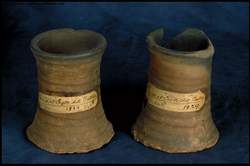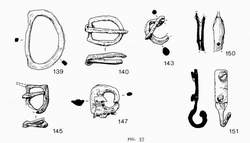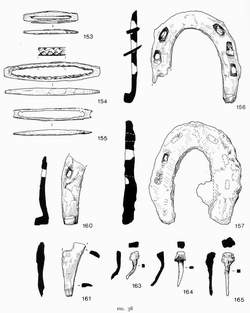Abandoned Communities ..... Shifting Sands
In the areas selected for excavation eight buildings were discovered. Some of them were interpreted as dwellings, but in others there were indications of industrial use. Four of the buildings were dated to the thirteenth century. They were constructed from timber, and possibly turf, but without clay or stone. All these buildings were roughly rectangular, between 4 and 5 metres wide internally, but varying in length between 6 and 12 metres. Three other buildings, constructed in the fourteenth century, made use of clay and stone, and were probably thatched with heather. The most complete of these three buildings had thick clay walls with stone and clay gables. It was rectangular, with entrances opposite each other near one end. There was evidence that the roof of this building was supported by wooden crucks.
On two tenements close to the north west side of the road evidence of industrial activity was found on either side of the stream. Within one tenement, interpreted as a pottery, several kilns were discovered, with associated storage pits. A building on the tenement may have been the workshop, the stream would have supplied a source of water, and clay may have been cut from a clay bed in a nearby boundary ditch.
Just across the stream from the pottery lay a tenement that yielded large quantities of the kind of debris produced by metal working. The ground surface of the whole property was stained black and grey from trampled ash, coal, and charcoal. Iron objects at various stages of manufacture were found, and much waste slag.
Products of the pottery and the metal-working tenement were found in the mansion and elsewhere in the village. They included fragments of jugs, jars, bowls, and urinals, but also more unusual objects such as horns for use in hunting or battle, and two aquamaniles, water containers with spouts in the form of a ram’s head. Iron objects found on the site included tools for black smithing and for woodworking; knives; horseshoes, spurs, and other items used in riding; staples and hinge pivots used in building, together with nails, and locks and keys; buckles; and candlesticks.
The article by Murray, Murray, et al. has many illustrations of the objects found at Rattray. Those reproduced on the left include:
• Buckles (139, 140, 143,145, 147), and strap end fittings from strap distributors (150, 151).
• Belt slides, probably from harnesses (153-155), horseshoes (156, 157, 160, 161), and horseshoe nails (163-165).
The analysis of the bones of animals, birds, and fish yielded a number of inferences. From studying the many cattle bones, for example, it was found that most of the cattle had been slaughtered after they had reached adulthood. It must have been possible to keep the cattle fed throughout the winter. Some of the horse bones had signs of butchery, indicating that horse meat was eaten, at least during periods of hardship.
Some of the bones of birds came from domestic species such as mallard ducks, geese, and chickens. A few bones from peacocks were also found. Other bones came from cormorants and other wild birds. Easily the most common fish was cod, though there were also a few findings of haddock and ling. Two bone fragments came from seals.
Animals caught by hunting included several species of deer, rabbits, hares, and wild pigs.
On two tenements close to the north west side of the road evidence of industrial activity was found on either side of the stream. Within one tenement, interpreted as a pottery, several kilns were discovered, with associated storage pits. A building on the tenement may have been the workshop, the stream would have supplied a source of water, and clay may have been cut from a clay bed in a nearby boundary ditch.
Just across the stream from the pottery lay a tenement that yielded large quantities of the kind of debris produced by metal working. The ground surface of the whole property was stained black and grey from trampled ash, coal, and charcoal. Iron objects at various stages of manufacture were found, and much waste slag.
Products of the pottery and the metal-
The article by Murray, Murray, et al. has many illustrations of the objects found at Rattray. Those reproduced on the left include:
• Buckles (139, 140, 143,145, 147), and strap end fittings from strap distributors (150, 151).
• Belt slides, probably from harnesses (153-
The analysis of the bones of animals, birds, and fish yielded a number of inferences. From studying the many cattle bones, for example, it was found that most of the cattle had been slaughtered after they had reached adulthood. It must have been possible to keep the cattle fed throughout the winter. Some of the horse bones had signs of butchery, indicating that horse meat was eaten, at least during periods of hardship.
Some of the bones of birds came from domestic species such as mallard ducks, geese, and chickens. A few bones from peacocks were also found. Other bones came from cormorants and other wild birds. Easily the most common fish was cod, though there were also a few findings of haddock and ling. Two bone fragments came from seals.
Animals caught by hunting included several species of deer, rabbits, hares, and wild pigs.
Three
Two fourteenth century pot stands, found in a kiln at Rattray in 1829.
This image comes from the website of the Marischal Virtual Museum.
This image comes from the website of the Marischal Virtual Museum.
Buckles and strap end fittings
Horseshoes and horseshoe nails


